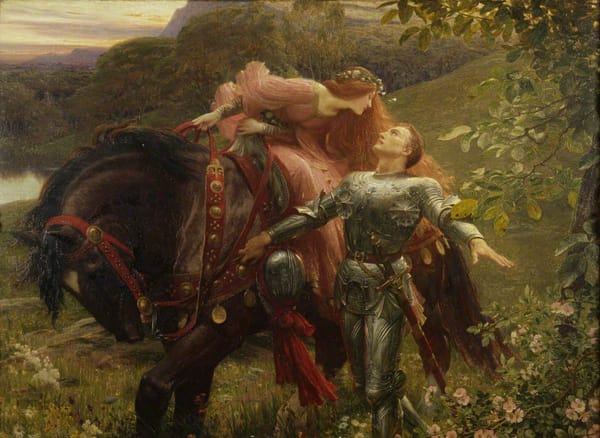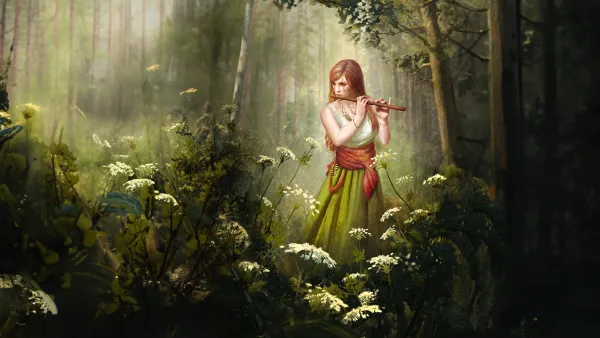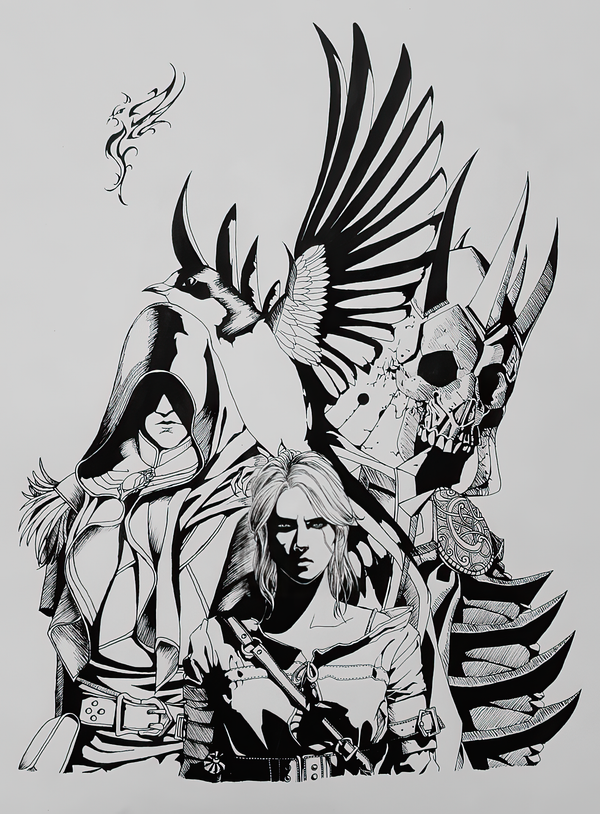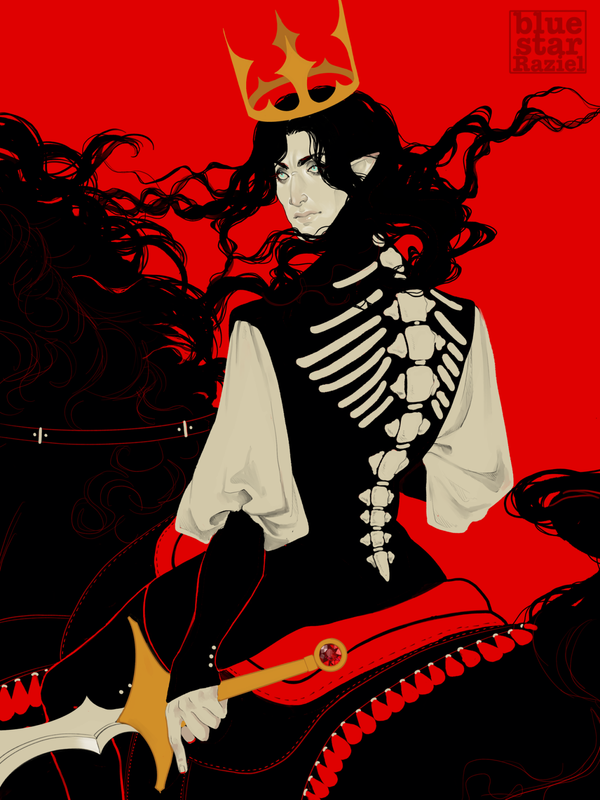Through the Looking Glass: Understanding Ard Gaeth & the Gate of Worlds
Between every reality in The Witcher lies a mirror-like barrier. As Ciri travels through time and space, we discover how the Gate of Worlds functions. Ard Gaeth, for example, seems but one special manifestation of interdimensional travel. And what about the elven towers? Let's see.
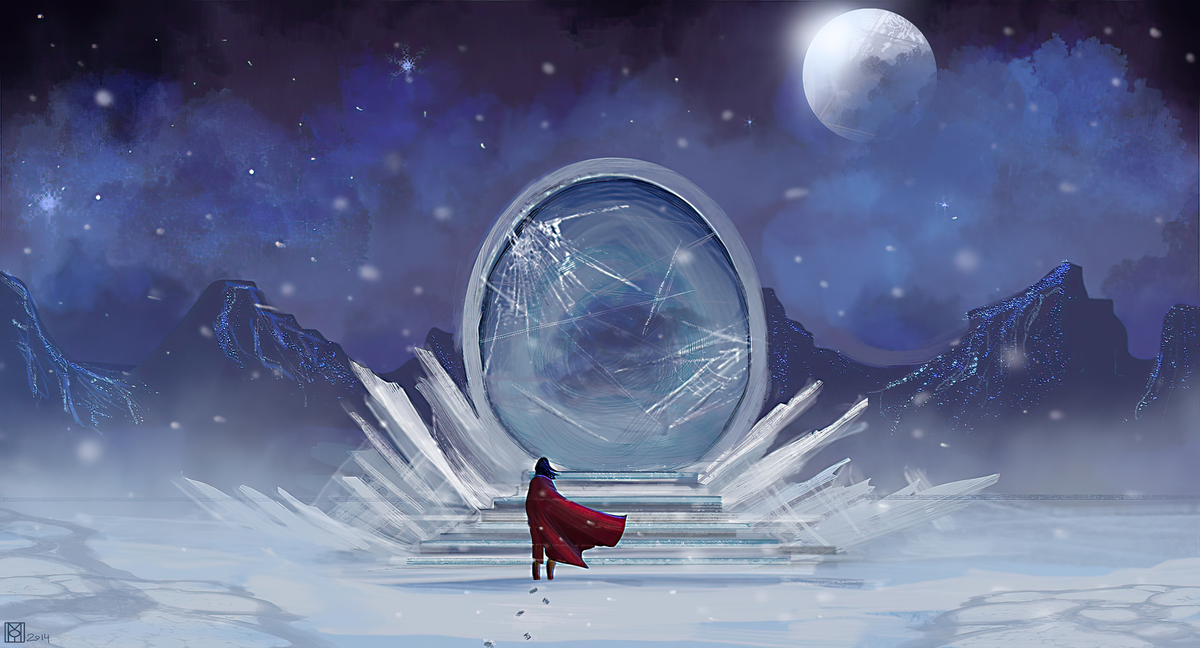
Contents
‘In short,’ Avallac’h continued, ‘it concerns the possibility of transferring between worlds not only oneself, one’s own–indeed–insignificant person. It concerns the opening of Ard Gaeth, the great and permanent Gateway, through which everyone would pass.’
– Avallac’h, Lady of the Lake
In The Witcher, interdimensional travel manifests through a phenomenon called the Gate of Worlds. While often conflated with Ard Gaeth – the great and permanent pathway – these concepts represent distinct aspects of reality manipulation. In the following, I’ll examine how the Gate of the Worlds functions and offer an interpretation about the nature of reality in Andrzej Sapkowski’s work.
Shorthand:
- Ard Gaeth ≠ Gate of Worlds, Threshold of Time.
- Ard Gaeth = ‘special case’ of Gate of Worlds.
- Every time someone with the Elder Blood ability travels between times & places, they access the so-called Gate of Worlds.
- Times and places are separated from each other by mirror glass.
- Interdimensional ‘portaling’ involves ripping a tear inside a glass-like canvas.
Extra detail:
- We may draw inspiration for interpreting the dynamics and appearance of the Gate of Worlds from Michael Ende’s The Neverending Story; there are notable similarities between it and The Temple of a Thousand Doors.
- Insofar as The Witcher is a notably intertextual, postmodern piece of literature, travelling in time and space the way Ciri does amounts to travelling in the imagination of the possible, among an infinite collection of reality variations.

Last January, I puzzled over Nimue’s ability to open the Gate of Worlds in Chapter 7 of Lady of the Lake. Weren’t only the bearers of Elder Blood supposed to be able to open it? Besides, wasn’t it a ‘great and permanent pathway’?
I had been conflating the Gate of Worlds with Ard Gaeth because several passages in Lady of the Lake do so, and because Aen Elle did not have access to Ard Gaeth in the final book. However, the Aen Elle did – and do – have access to the Gate of Worlds which is accessible inside the Tower of the Swallow. Similarly, what Ciri does while hopping between times and places – what special individuals among the Aen Alle can do in their presently constrained capacity – involves crossing the Threshold of Time and Space.
It seems that this might be a loosely deployed and underdefined term. Perhaps. Perhaps though, more meaning is to be found in dividing the two phenomena; call them jokingly ‘Smol Gaeth’ and ‘Ard Gaeth’. Ard Gaeth remaining a great and permanent pathway, whereas ‘Smol Gaeth’ would stand in for a practice. (Both might be better conceived of as of methods not entities.)
In addition, for clarifying how crossing the Threshold of Time works, it might be useful to turn to Michael Ende and his thoughts on ‘wish’ and ‘belief’.
‘Portals’ or Tears in the Mirror
What is it like to enter another reality?
In The Witcher’s textual multiverse, worlds – times and places, dimensions an spheres – are like glass splinters reflected in each other in a giant polyhedron solid. Places and times can mirror each other, though not perfectly. They exist as possibilities. To enter one is a akin to ripping open a canvas or making a crack in a mirror; metaphorically, as well as literally.
The image blurred and shattered, as painted glass shatters, suddenly fell to pieces, disintegrated into a rainbow-coloured twinkling of sparkles, gleaming and gold. And then all of it vanished.
[…]
The night air above the lake ruptured, like a smashed stained-glass window cracks. A black horse emerged from the crack.
– Andrzej Sapkowski, Lady of the Lake
It would appear that upon breaching a shard of reality, upon entering it, you alter the reflection of the world into which you pass. Splitting a mirroring surface, you facture the image reflected within, as you become part of another variation of the story in the tapestry of myth and legend. This way, the number of ‘tears’ reflected in each other can grow infinitely, as inside a giant polyhedron.
Something creaked, just like canvas being torn. The terns rose with a cry and a fluttering, for a moment covering everything in a white cloud. The air above the cliff suddenly vibrated and became blurred like glass with water spilled over it. And then it shattered like glass. And darkness poured out of the rupture, while riders spilled out of the darkness. Around their shoulders fluttered cloaks whose vermilion-amaranth-crimson colour brought to mind the glow of a fire in a sky lit up by the blaze of the setting sun.
Dearg Ruadhri. The Red Horsemen.
[…]
But the air also ruptured in another place, and from the rupture, cloaks fluttering like wings, rushed out more horsemen.
– Andrzej Sapkowski, Lady of the Lake
In these examples, we witness Ciri’s attempts at moving between times and places. The barrier between worlds, as described, is like a window pane.
Or a looking glass.
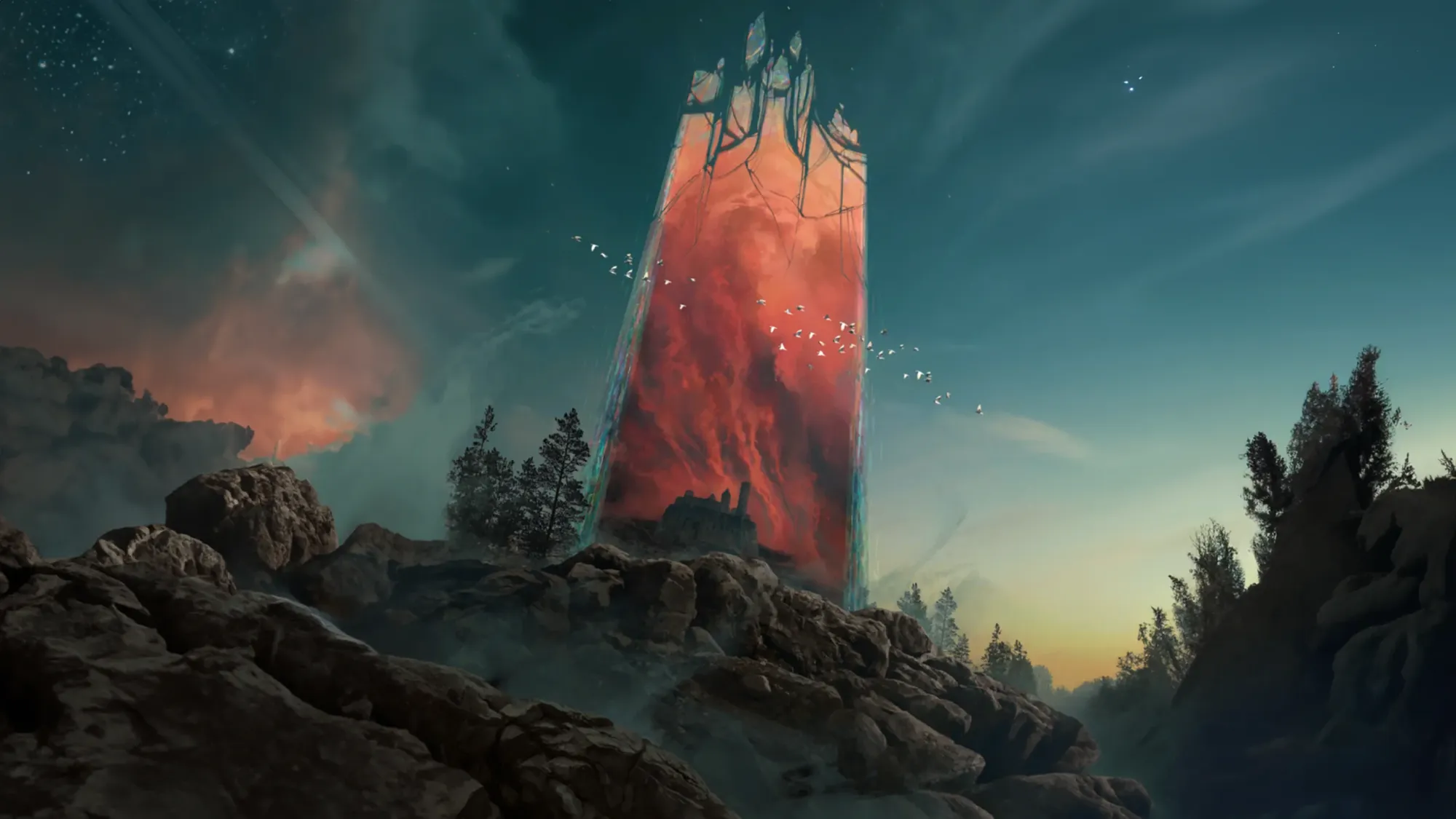
Ciri leapt up from the bed, and hurled the looking glass at the wall with great force. The amber frame smashed and the glass shattered into a million splinters.
– Andrzej Sapkowski, Lady of the Lake
Mirrors, and mirroring, obtain quite a significance in Lady of the Lake. A lake stretches across times and places, spanning like a bridge, smooth as a looking glass. Then dreams, those perpetually warping mirror images of the dreamers’ desires, fears, and longings. Shakespeare’s ‘We are such stuff As dreams are made on, and our little life Is rounded wit ha sleep,’ prefaces the last book, followed by Poe’s ‘All we see or seem Is but a dream within a dream’ and Vysogota of Corvo’s ‘Everything has been, everything has happened. And everything has already been written about.’
Words can only imitate words, so the quality of the reality Sapkowski conjures is repeatedly implied to be reflective. We come across mirrors that sorceresses use for video calls and substances the Knowing Ones use for scrying. In the Alder King’s looking glass, we encounter a version of The Mirror of Galadriel, capable of showing things that are occurring, have occurred, or are yet to occur; the ‘now’ is relative, after all. And then, there is Hartmann’s looking glass, which belongs to Nimue.
‘That looking glass... It’s magical, isn’t it?’
‘No. I squeeze my pimples in front of it.’
[…]
‘Is it true,’ asked Condwiramurs in a voice trembling with excitement, ‘that from Hartmann’s looking glass you can pass into other–’
‘Worlds? Indeed. But not at once, not without preparation, meditation, concentration and a whole host of other things. [...] Something may also emerge from Hartmann’s looking glass.’
– Andrzej Sapkowski, Lady of the Lake
We do not actually witness anyone passing through Hartmann’s looking glass into another time and place. We do see, however, how the item helps to summon an image out of one particular legend, an artwork woven into a tapestry that Nimue sets aflame with magic. An artwork is a reflection of a time and place, it functions as a metaphorical portal or window into a different reality. Nimue here is bringing a static artistic representation, a reflection of another time and place, to life. It is Ciri, who steps inside this image, this reflected reality, rendering it a Gate of Worlds.
Navigating Between Worlds: Doors Into Possibilities
What is it like on the Threshold of Time, when passing through the Gate of Worlds? First, there is soft, black darkness. Then things obtain geometry.
At first, the inside of the tower reminded her of Kaer Morhen – the same long, black corridor behind a colonnade, the same unending abyss in the perspective of columns or statues. It was beyond comprehension how that abyss could fit into the slender obelisk of the tower. But she knew, of course, that there was no point analysing it – not in the case of a tower that had risen up from nothingness, appearing where it had not been before. There could be anything in such a tower and one ought not to be surprised by anything.
The colonnade she had ridden into blazed with an unnatural brilliance.
Kelpie’s hooves rang on the floor; something crunched under them. Bones. Skulls, shinbones, ribcages, thighbones, hipbones. She was riding through a gigantic ossuarium. Kaer Morhen, she thought, recalling. The dead should be buried in the ground… How long ago that was… I still believed in something like that then… In the majesty of death, in respect for the dead… But death is simply death.
She rode into the gloom, under the colonnade, among the columns and statues. The darkness undulated like smoke. Her ears were filled with intrusive whispers, sighs, and soft incantations. Suddenly brightness flamed before her, as a gigantic door opened. One door opened after another. Doors. An infinite number of heavy doors opened before her without a murmur.
Kelpie went on, horseshoes resounding on the floor.
The geometry of the walls, arcades and columns surrounding her was suddenly disrupted; so confusingly that Ciri felt dizzy. She felt as though she were inside an impossible, multifaceted solid, some gigantic polyhedron.
The doors kept opening. But now they weren’t delineating a single direction. They were pointing to infinite directions and possibilities.
– Andrzej Sapkowski, The Tower of the Swallow
Soft, black darkness as in a dream – before imagination can start weaving its magic.
When Ciri rides into the Tower of the Swallow, she witnesses all possible times simultaneously; likely according to what matters to her, but not only. She sees things which have happened, which are happening, and which might yet happen. As she nears the end of her journey, she discovers she can also converse with Vysogota, who has passed on into the spirit realm.
Within Tor Zireael, Ciri could pass into many realities, but she is drawn unconsciously toward the one the builders of the elven tower linked to it. She is proving her blood and lineage, which allow her to access the Gate of Worlds within the support framework the elven tower provides. Later, when Ciri is escaping through time and space from her pursuers on her own, she is also accessing the Gate of Worlds, but without the handrails. She simply ends up in a place within an equally large variety of possible places, but without the chance to peek what could be behind the door she ends up squeezing through. There is no geometry to Ciri’s way, no cached realities to witness in the soft, black darkness.
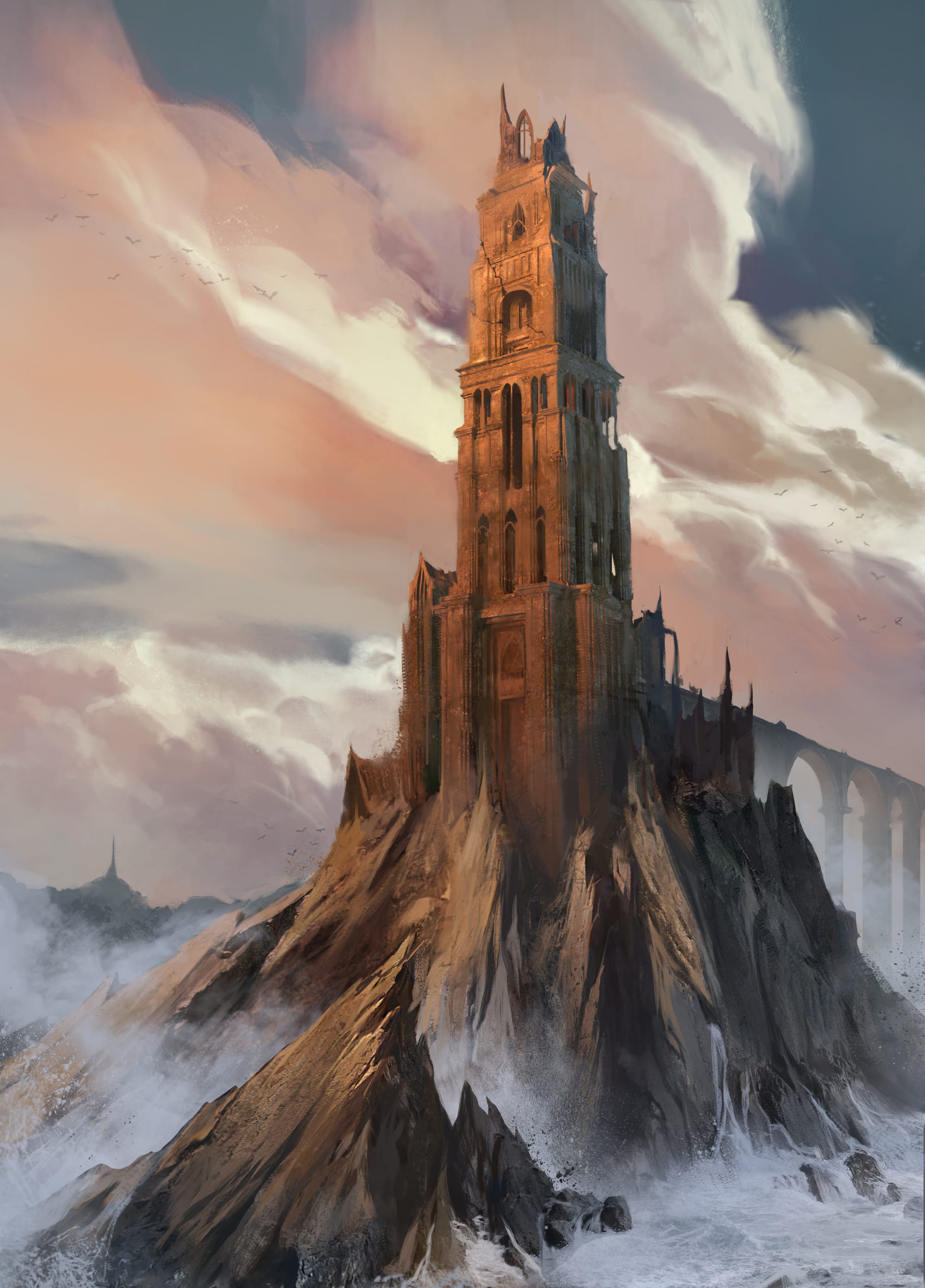
It seems like the skill of moving through the Gate of Worlds could have something to do with imagination and creativity, enabling the cruising of possibilities. Ontologically, The Witcher exists at crossroads, where different dimensions of time (mythical, historical) and alternative worlds (literary, empirical/material) interpenetrate the legend.
Insofar as other times and places exist as possibilities, they resemble, for example, Roger Zelazny’s shadows and Michael Ende’s imagination. In The Chronicles of Amber, walking in the shadows of the city of Amber is to walk in an infinite variation of reflections, and to reach one such reflection is to simultaneously create it. In The Neverending Story, Ende sees the creation of literature, that is, the transformation of dynamic imagination into static text, as a sort of death that an author can only hope leads to rebirth in the imagination of its readers. That’s what constitutes the rebirth of the world. And Bastian, the protagonist whose imagination builds the story toward its end in a story that also contains its own new beginning (an Ouroboros), is the vehicle. Much like Ciri.
Here is the description of The Temple of a Thousand Doors from The Neverending Story, which calls to mind the inside of The Tower of the Swallow.
*It was a hexagonal room, rather like the enlarged cell of a honeycomb. […] There were doors that looked like large keyholes, and others that resembled the entrances to caves, there were golden doors and rusty iron doors, some were padded and some were studded with nails,…
Bastian had passed many times from one hexagonal room to another. Every decision he made led to another decision that led to yet another decision. But after all these decisions he was still in the Temple of a Thousand Doors. […] His wish had sufficed to lead him into the maze, but apparently it was not definite enough to enable him to find the way out. […] Thus far his decisions had been based on mere whim and involved very little thought. In every case he might just as well have taken the other door. At this rate he would never find his way out.*
– Michael Ende, The Neverending Story
Fantastica is the realm of human imagination, recorded in a tale that is reflecting its own nature infinitely. How does moving through the Temple of a Thousand Doors work, exactly? Where can one find it, how does one enter it, and how to leave it?
‘There is in Fantastica a certain place from which one can go anywhere and which can be reached from anywhere. We call it the Temple of a Thousand Doors. No one has ever seen it from outside. The inside is a maze of doors. Anyone wishing to know it must dare to enter it.’
’How will I find the entrance?’
‘You’ve got to wish it.’
’Every door in Fantastica,’ said the lion, ‘even the most ordinary stable, kitchen, or cupboard door, can become the entrance to the Temple of a Thousand Doors at the right moment. And none of these thousand doors leads back to where one came from. There is no return.’
‘Only a genuine wish can lead you through the maze of the thousand doors. Without a genuine wish, you just have to wander around until you know what you really want. And that can take a long time.’
– Michael Ende, The Neverending Story
The place opens only to the one who genuinely wishes to find it, while every door can become the entrance; much like how every place can be made an access point to the Gate of Worlds with a little know how. From there, it’s possible to reach anywhere and any time by passing through its maze, much like within the Tower of the Swallow. Finally, to make the phenomenon work in the way you want, you have to first know what it is that you genuinely wish and are looking for.
But Tor Zireael only works for those bearing Elder Blood! I hear you. You need to be a special individual to enter such an impossible place of endless possibility. It helps if you are the protagonist, for example. Or rather, someone around whose actions the fate of the story at hand shapes itself. The Witcher and The Neverending Story both transcend the boundaries of their own tale by building their world around self-awareness of their nature – as stories.
Bastian finds the entrance to the Temple of a Thousand Doors when an inner voice calls him away. He finds the Door at the exact and only moment he can possibly find it in order to push forward his and Fantastica’s story; just like he found the book that needed him as a character to complete its tale. Ciri finds her way to the Tower of the Swallow similarly, thanks to assistance placed in her way by an elf, who is aware this story is unfolding within a particular narrative. A book by Buyvid Backhuysen results from Avallac’h’s personal meddling with the history of The Witcher’s world a good hundred years before Ciri’s birth.
Ciri herself moreover is pushed on by a multi-pronged wish: she wishes to move beyond the reach of her enemies threatening her in her birth-world; she wishes to help her loved ones who, she dreams, are in peril; and she wishes to return to a time and place where things are ‘like it used to be’. By contrast, Bastian wishes to be surrounded by people again and show off his abilities.
Can any character do anything at all without (us) wishing for it?
Perhaps then, in addition to special genes, a ‘targeted wish’ plays an equally important role in allowing the Elder Blooded summon or find and use the Gate of Worlds. When Ciri wished for a way to escape in Thanedd, the portal in Tor Lara appeared suddenly and, as Ciri notes, ‘just in time as though she had summoned it.’ As in Ende’s tale so in Sapkowski’s: teleporters are never visible. But the Chosen have stories to finish and that is what plot devices do for the Chosen: appear, when they are most needed.
The Temple and the Tower are but crutches for the principle of ‘wishing and making your wish become reality.’ Bastian has AURYN, Ciri has Hen Ichaer. Ciri must know what she wants while escaping in time and space with Ihuarraquax. She calls forth in her memory the sight of two moons over warm moors, repeating in her mind what she wants, and takes the plunge.
…a cool brightness–the brightness of knowledge and power–quickly came over her. She had no idea where the knowledge and power were coming from, where their roots and source originated. But she knew she could do it. That she would do it if she wanted.
– Andrzej Sapkowsi, Lady of the Lake
She learns the power of her blood by learning to wish.
Perhaps not imagine places or faces, she thought, but strongly desire … Strongly wish for something, very strongly, right from my belly …
– Ciri, Lady of the Lake
Soft, black darkness first, and then – a vision. It’s not unlike creating, or dreaming up stories, pulling tales out of thin air in order to be able to go there. (No offence to Condwiramurs, but dreams are a little bit like library cards after all.) However, as in The Neverending Story, where AURYN’s power comes from doing not merely imagining, so in The Witcher:
‘In short, life in a dream. And life, Madam Vigo, may be a dream, may also finish as a dream … But it’s a dream that has to be dreamed actively.’
– Regis, Lady of the Lake
Conclusion
’This is Tor Zireael, the Tower of the Swallow. This is the Gate of Worlds and the Threshold of Time. Feast your eyes on this sight, man, for not to everyone nor always is it given.’
– Avallac’h, The Tower of the Swallow
The Gate of Worlds, the Threshold of Time, is a phenomenon. Ard Gaeth – the great and permanent pathway – is more like a special, strengthened framework for using the Gate of Worlds.
The Aen Elle have not lost all ability to pass from reality to reality; they simply lack a potent enough of a dreamer-demiurge to create and stabilise a path into a reality that is exactly of the kind they would prefer. Meanwhile, when the biggest fan of the Witcher legend summons the Gate of Worlds in Lady of the Lake, it seems to be about practicing a method to the best of her abilities (and with a little magical help). Nimue helps Ciri know which reality to wish for (according to Nimue’s extensive research – and preference – on a legend sprouting variations of itself like reflections of stars in a lake).
For only Ciri can render a canvas, a page in a book, a Gate of Worlds.
Nimue calmly held out her hands, chanting a spell. The tapestry hanging on the stand suddenly burst into flames [...] The tiny lights reflected in the oval of the looking glass, danced, teemed in the glass like coloured bees and suddenly flowed out like a rainbow-coloured apparition, a widening streak, making everything as bright as day.
The black mare reared up and neighed wildly. Nimue spread wide her arms violently, and screamed a formula. Condwiramurs, seeing the image forming and growing in the air, focused intently. The image gained in clarity at once. It became a portal. A gate beyond which was visible…
A plateau full of shipwrecks. A castle embedded in the sharp rocks of a cliff, towering over the black looking glass of a mountain lake…
‘This way!’ Nimue screamed piercingly. ‘This is the way you must take! Ciri, daughter of Pavetta! Enter the portal, take the road leading to your encounter with destiny. May the wheel of time close! May the serpent Ouroboros sink its teeth into its own tail!’
‘Roam no more! Hurry, hurry to help your friends! This is the right way, O, witcher girl.’
The girl in the saddle turned her head, looking now at them, now at the image called up by the tapestry and the looking glass.
They saw the mare spurred on... And then everything vanished.
Without a word... they both turned around towards the place where the Gate of the Worlds had vanished.
– Andrzej Sapkowski, Lady of the Lake
In a reflection of the readers’ experience of Andrzej Sapkowski’s tale, the closing of the wheel of time is accomplished by wishing along with Ciri for her to get back into that one particular time and place in which lies the story Ciri needs to finish – this time.
Marginalia
When Ciri jumps ahead 4 days in time in Tower of the Swallow, various people connected to her get a premonition that she has died, passed on. To be in-between, in all places and times and none, inside the indecision of the writer’s mind, is to be as if dead until summoned back into existence.
When Vysogota says at the end of The Tower of the Swallow that he had known Ciri would prevail because he had read about it, it’s because the nature of Ciri’s tale has already been recorded in some form or another. In passing on, in encountering Ciri in this timeless realm of possibilities we can imagine, Vysogota has learned about the nature of the power Elder Blood possesses. Mastery over the conceivable, and as of yet inconceivable. For figuring out what you really, truly want to be the case is just about the hardest thing in the world.

